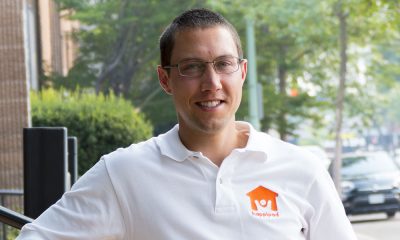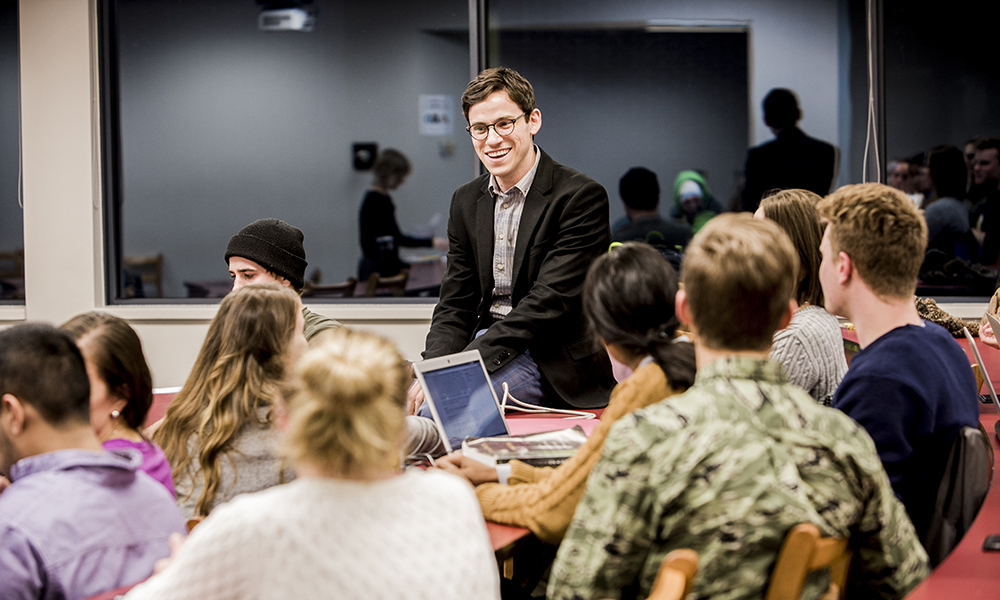
THERE IS THE MAN WITH THE TWO DOGS TIED TO THE PARKING METER THAT ASKS FOR CHANGE. There’s the young couple huddled in the doorway of the abandoned building with the cardboard sign: “Be the Change.” And then there are all those that cannot be seen—still seeking a place to call home.
UBC Okanagan researchers, profs and alumni are working on being that change. And they are starting right here in the Okanagan.
According to the recent Journey Home Strategy from the City of Kelowna, 2,000 people in the city will experience homelessness at some point during the course of a year. As our populations bloom, homelessness may feel like an inevitable and insurmountable issue. The most recent global survey by Habitat for Humanity in 2016 estimated 1.6 billion people lacked adequate shelter.
UBCO researchers are determined to find effective and more connected solutions to the growing global crisis of homelessness. The commonality in their pursuit for solutions: collaboration.
Cailan Libby: The Matchmaker
School of Engineering alumnus Cailan Libby paces authoritatively as he speaks on his cell in the open-concept office of his start-up, Happipad. Housed within the Innovation UBC Hub at Kelowna’s downtown Innovation Centre, Happipad is a home-sharing app that aims to solve BC’s affordable housing shortage. And Kelowna is the testing grounds.
Happipad is similar to a dating app. More akin to Match.com than Tinder, Happipad asks both renters and hosts to fill out a fairly thorough questionnaire on interests, habits, likes and dislikes. The app then connects compatible ‘hosts’ and ‘guests’ online so they can arrange an in-person interview and potentially strike a living arrangement.
“Simply put—it’s non-romantic match making,” says Libby, whose personal experience as both a renter and landlord opened his eyes to the need for Happipad.
 “If you have granite countertops or not, or if your place is 800 square-feet or 700 square-feet, doesn’t really matter. These are not factors that dictate if people will have an enjoyable living experience.
“If you have granite countertops or not, or if your place is 800 square-feet or 700 square-feet, doesn’t really matter. These are not factors that dictate if people will have an enjoyable living experience.
“Instead, if you look at: How does this home operate? Who lives here? What do these people like to do? Are their personalities similar? These are things that make an enjoyable living experience. That is what our focus is on.”
Libby co-founded the app in his last year as an undergrad with the mentorship of UBC Okanagan Prof. Ken Chau.
Libby and Chau met one night and brainstormed 50 of the world’s most pressing problems that could be solved. Housing, student housing in particular, was one of their top three.
“Since the 1940s the average number of people per home has halved but the average size of homes has doubled. We have a lot of space not being used,” says Libby, his voice gathering enthusiasm.
“In Kelowna we have over 30,000 households. Primary occupants are 50-plus, with no children in the homes and one or more spare bedrooms. We have a lot of capacity. That’s nearly two times our post-secondary population that we can house just in spare bedrooms.
“Taking this all into account, we thought, ‘Hey, there’s something here. There is a way we can solve our housing problem without building more inventory.’”
Libby started working on the Happipad concept in summer 2016 and launched the first web platform the following summer. He soon realized the tool was too generic and wasn’t attracting the main host demographic—the retired population.
“It came down to trust, transparency, privacy and security,” explains Libby, who regrouped in late 2017 to redesign the home-sharing service, shifting to address the concerns of “empty nesters”.
“We have this idea of the nuclear family, the single-family home with all this space. We are not accustomed to sharing our space with strangers.”
Entreprenerds: Cailan Libby and Prof. Ken Chau
Since the redesign, the number of senior hosts has doubled. And Happipad is now exceeding Libby’s expectations.
“At first, I thought senior home owners are going to want a young person around to shovel snow and to help with the chores. That’s been so far from the truth. It’s actually the reverse. They want to help the younger generation,” says Libby, noting Happipad’s oldest host is nearly 90. “They want to give back.”
Libby’s voice is imbued with an infectious sense of hope as he recounts recent success stories.
“One of our hosts is a widow in her mid 80s and we connected her with a recent grad from Israel. At first it was a little bit awkward, but after a time she starts to really enjoy having the company. She actually called me up a couple months ago and says, ‘You’ll never guess what happened? I was getting ready for church and the young man asked to join me and he’s been coming ever since.’
“It’s really interesting to see how these people living together have an influence on each other,” says Libby.
“We have a single mother with a son in middle school and we connected her with an engineering school student. This has been a blessing to her,” says Libby. “She has an extra income now and they say they feel more structured and organized. They have this extra element in the household that brings a new balance. They share meals together, they operate as a unit and help each other out.”
Turns out Happipad, while not yet entirely solving the rental shortage, has helped address other social issues like isolation and loneliness.
“People have loved it. It’s something that hasn’t ever really been offered,” says Libby.
Libby has plans to launch the app province-wide this year, focusing on university-centric cities to start.
Mapping the Way Home
As Libby has shown with Happipad, digital communication technologies have amazing potential to connect people and services.
UBC Okanagan doctoral candidate, Shelley Cook, won a national scholarship (The 2017 Dr. Alexander Aylett Graduate Scholarship in Urban Sustainability and Innovation) for her leadership on iSearch—a geomapping technology developed to connect Kelowna’s homeless with housing and essential services.
The web-based spatial database of housing and homelessness services in Kelowna directs users to available resources and allows service-providers to update information in real-time.
 “Of primary concern for homeless people is how to locate a place to sleep and where to access emergency support, like food, clothing, or showers, as well as other essential services,” says Cook.
“Of primary concern for homeless people is how to locate a place to sleep and where to access emergency support, like food, clothing, or showers, as well as other essential services,” says Cook.
The web-based system allows users to identify available shelters, low-income housing, and related support agencies geographically on a digital map of Kelowna and the surrounding area.
“A city might have all the services required for homeless people to overcome many of their challenges—but first they must be able to identify and locate them,” explains Cook. “Essentially, iSearch is the only comprehensive directory of all homelessness services in the Central Okanagan available through one straight-forward, user-friendly interface.”
Developed in the Spatial Information for Community Engagement Lab at UBCO, iSearch involved community-based research collaboration between UBC Okanagan, Okanagan College, and local and national funders.
“A city might have all the services required for homeless people to overcome many of their challenges—but first they must be able to identify and locate them.”
To create the map, Cook and a team of UBCO researchers contacted each of the 84 different organizations in the Kelowna region that provide critical services and resources for the homeless.
“We asked them a series of questions related to the services they offered and took that information to craft this online spatial database,” explains Cook.
This spatial database—or geomap—enables people to quickly sift through large amounts of information to find the precise services they need, whether it’s their next meal, medical assistance, or a shelter for the night.
iSearch can be used with simple targeted questions like: “Show me all the examples of where I can get a hot meal. Or where can I get a hot meal and do my laundry?”
The platform launched publicly in March of 2017 and is being promoted and used at service agencies across Kelowna. A stand-alone kiosk is also available in the downtown Kelowna Regional Library so homeless can access the tool.
Geography Associate Prof. Jon Corbett, who collaborated with Cook on the project, says their research revealed repetition and redundancy within the services being offered.
“What we intended to do was to produce an interactive map that contained real-time data that actually showed the different services and resources being offered by organizations across the entire landscape of Kelowna,” says Corbett.
Corbett says the geomap will improve the lives of the homeless because it helps them better understand what services are available and provides “entry points” for access.
“It’s not necessarily a direct contributor to the resolution of homelessness but it enables people to access the services they need in order to assist with the issue. And it helps service providers themselves,” explains Corbett. “From that perspective, it’s a huge contribution to enabling people to be able to access the correct services in a timely way and help them make changes in their own lives.”
Mapping a way to an improved life and out of homelessness starts with knowing where to get the support needed, says Cook.
“In the end,” says Cook, “the goal of technology becomes about enhancing service equity and quality of life.”
Engineering Hope
The shopping cart rattles along the sidewalk with a broken wheel. At the curb it tips, spilling its contents into the middle of the road. Car horns blare as a distraught man scrambles to pick up the empty cans and bottles he hopes will pay for his dinner.
An engineering student may not consider the plight of this man an engineering problem. But Prof. Ray Taheri in the School of Engineering wants his students to think again.
“I remind my first-year design students to think of the community impact on the people and the planet, not simply the profit,” says Taheri, always an advocate of engineering with compassion.
“When you come to my class, the first slide is: Public safety and health is paramount. I always tell my students that engineers are applied scientists and the number one duty you have is to the public. Scientists aim to know. Engineers aim to do.”
Taheri and his students are applying inclusive engineering to design solutions for pressing, far-reaching issues facing the visibly homeless.
Three years ago his students collaborated with homeless populations and members of the Metro Community Church to design innovative personal belongings carriers to replace the ubiquitous shopping cart.
The first prototype was built by graduate engineering students in the UBCO Composites and Optimization Laboratory and rolled onto Kelowna streets last year.
PhD engineering student Bryn Crawford is leading the implementation of the project.
By helping manage personal belongings the carts foster a sense of ownership and pride for users, says Crawford.
Crawford and his team, in collaboration with faculty members from UBCO’s School of Social Work, are gathering information from the homeless populations testing the carts.
“When designing something for someone, it’s essential that the person, the end user, is the most important,” says Crawford.
Ultimately the team wants to understand if there is a connection between the experience of the street community who have successfully found housing and the personal belongings cart.
Once the School of Social Work returns results from homeless people testing the carts, it will be back to the lab for the engineering team to refine the design based on feedback.
“The engineering work hasn’t ended yet,” says Crawford.
For Taheri and his engineering students the next project is already in the design phase.
More recently, following a series of fatal accidents in which people became trapped inside the hatches of clothing donation bins, Taheri asked his students to conceptualize a safer design.
“Unfortunately, these people are desperate and they do not make rational decisions,” says Taheri. “We should include homeless people in the conversation. For this particular problem, you should include them and ask them: Have you ever climbed in one of them? What prompts you to do it?”
UBC engineering students tasked with designing safer donation bins after series of deaths https://t.co/5HjHQrZUQu
— Benoit-Antoine Bacon (@ubcprez) January 6, 2019
Taheri says always being mindful of community and social impact is key to creating change in engineering and design.
“When it directly impacts people and they can see the results of their work, the students are very proud of it. We all want to see the outcome of our actions.”
The Invisible Homeless
While the man pushing a can-filled shopping cart or the couple panhandling in the doorway may come readily to mind when homelessness is mentioned, political science Assistant Prof. Carey Doberstein says we need to check our bias.
His research in several large Canadian cities that count and survey people experiencing homelessness reveal some interesting stats that challenge these stereotypes.
“Large numbers of those in the shelter system actually work for a living,” says Doberstein, who has examined facets of homelessness for a decade. “The money they make in lower skilled jobs often does not come close to affording housing.”
A 2014 Statistics Canada report found that one in every five households spend over 50 per cent of their income on rent, putting them at risk of homelessness.

The Out of Reach 2018 study by the National Low Income Housing Coalition in the United States finds that someone working 40 hours a week at a minimum wage of US$7.25 an hour is unable to afford a one-bedroom apartment at fair market rent in any American state. According to the study, a person must earn at least US$16.35 an hour to afford a one-bedroom apartment without spending more than 30 per cent of their income on shelter.
Doberstein’s 2016 book, Building a Collaborative Advantage: Network Governance and Homelessness Policy-Making in Canada, explores how progressive and innovative policy can emerge from inclusive and collaborative decision making.
If collaboration is key, it appears the City of Kelowna may be on the right track with its adoption of the Journey Home Strategy in June 2018.
The strategy focuses on inclusivity and collaboration and promises $45-million towards addressing homeless over the next five years.
“What’s really needed are civil society actors that have expertise and knowledge from the ground, who know the real dynamics on the ground, and are given genuine levers of government authority and power to work with government to devise more creative and comprehensive policy decisions,” says Doberstein.
“Experiencing homelessness is really tough on people. I firmly believe, regardless of political stripe, people are generally compassionate if they learn about the complex pathways that some people have faced on their way to homelessness.”
Doberstein has surveyed people of all different backgrounds and political leanings in his studies of homelessness. What he has come to is that—more than anything—the intimate, human element of story is what moves people to act.
“Experiencing homelessness is really tough on people. I firmly believe, regardless of political stripe, people are generally compassionate if they learn about the complex pathways that some people have faced on their way to homelessness.”
—Written by Craig Carpenter


